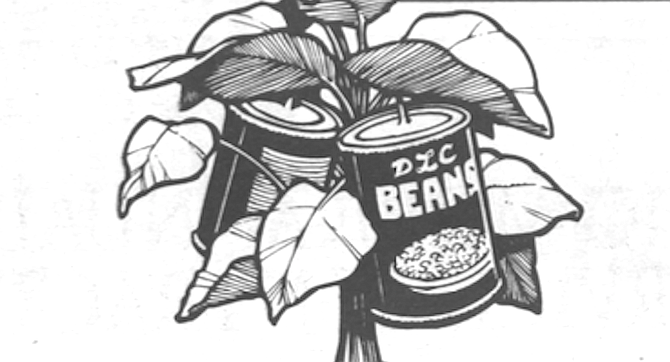 Facebook
Facebook
 X
X
 Instagram
Instagram
 TikTok
TikTok
 Youtube
Youtube

Dear Matthew Alice: Why is it that some beans can be purchased fresh, dried, or canned, but some beans cannot be found anywhere in their fresh state, i.e., kidney beans, lima beans, pinto beans, garbanzos. I'm especially curious about kidney beans. I have never seen them fresh in any food market. — James Vega, San Diego
So we here at the Alice Foundation for Bean Research and Alternative Fuel Development don't miss a thing, Mr. Vega has kindly supplied a hand-drawn chart of legumes, with variety on the y axis and marketing alternatives on the x. You need to know: Are green beans available? Just match the axes and there you are. As simple as that sounds, beans do hide a few secrets we chili eaters hardly consider. Like the fact that kidney beans are available fresh in any way not in a form we call “kidney.” What follows is some legume lore and the romance of the bean.
Once upon a time there were two major bunches of beans, the European fava or bean and the New World haricot. “Haricot” is our mangling of the original Aztec Nahuatl ayacotl. From one type of wild plant the Aztecs developed varieties of beans, different in color and shape, but all just variations on the same thing. So when you look in the bean bins at Chowmart, you can find navy, white northern, pinto, black, pink, kidney, pea bean, and some others. They’re all the dried, mature seeds of varieties of the basic haricot. If the haricot is harvested very young, while the pod is green and succulent and the seeds are barely developed we call them green beans, the things the kids push around their plates or try to feed to the dog under the table. Leave the plant alone until the seeds are fully developed and the pods are dry, then you have kidney, pinto, navy, etc. So if you’ve bought green beans in the produce section you’ve bought “fresh” kidney beans. Sort of.
There’s little point in selling kidney beans before they’re completely dry. They’d be hard to store and handle, and there’s nothing you could do with them that you can’t do with the dry form.
Lima beans are green beans’ cousins. You can find them in dry, mature form, but the ones they freeze are simply harvested at a stage where the bean is just beginning to mature, before it dries out. According to archaeological records, kids have been making faces and spitting limas back onto their plates for at least 7000, 8000 years. They came from Peru and are named for the capital city, which means they’re really Lee-ma beans. Though that won’t make them any better. So there you go. The leguminous truth. It’s bean a pleasure.


Dear Matthew Alice: Why is it that some beans can be purchased fresh, dried, or canned, but some beans cannot be found anywhere in their fresh state, i.e., kidney beans, lima beans, pinto beans, garbanzos. I'm especially curious about kidney beans. I have never seen them fresh in any food market. — James Vega, San Diego
So we here at the Alice Foundation for Bean Research and Alternative Fuel Development don't miss a thing, Mr. Vega has kindly supplied a hand-drawn chart of legumes, with variety on the y axis and marketing alternatives on the x. You need to know: Are green beans available? Just match the axes and there you are. As simple as that sounds, beans do hide a few secrets we chili eaters hardly consider. Like the fact that kidney beans are available fresh in any way not in a form we call “kidney.” What follows is some legume lore and the romance of the bean.
Once upon a time there were two major bunches of beans, the European fava or bean and the New World haricot. “Haricot” is our mangling of the original Aztec Nahuatl ayacotl. From one type of wild plant the Aztecs developed varieties of beans, different in color and shape, but all just variations on the same thing. So when you look in the bean bins at Chowmart, you can find navy, white northern, pinto, black, pink, kidney, pea bean, and some others. They’re all the dried, mature seeds of varieties of the basic haricot. If the haricot is harvested very young, while the pod is green and succulent and the seeds are barely developed we call them green beans, the things the kids push around their plates or try to feed to the dog under the table. Leave the plant alone until the seeds are fully developed and the pods are dry, then you have kidney, pinto, navy, etc. So if you’ve bought green beans in the produce section you’ve bought “fresh” kidney beans. Sort of.
There’s little point in selling kidney beans before they’re completely dry. They’d be hard to store and handle, and there’s nothing you could do with them that you can’t do with the dry form.
Lima beans are green beans’ cousins. You can find them in dry, mature form, but the ones they freeze are simply harvested at a stage where the bean is just beginning to mature, before it dries out. According to archaeological records, kids have been making faces and spitting limas back onto their plates for at least 7000, 8000 years. They came from Peru and are named for the capital city, which means they’re really Lee-ma beans. Though that won’t make them any better. So there you go. The leguminous truth. It’s bean a pleasure.
Comments